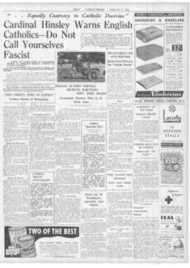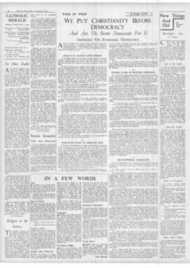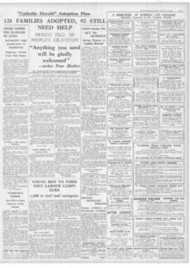Page 15, 3rd February 1939
Page 15

Report an error
Noticed an error on this page?If you've noticed an error in this article please click here to report it.
Tags
Share
Related articles
Father Hudson Brought Up 25,000 Children An English...
Christmas Masses On Television And Radio
Obituary Mgr. Canon Hudson
Profession Broadcast
Radio Plea To Christians
HE HAD 25,000 IN HIS FAMILY
Work of Pioneer in Child Rescue Recalled
M.P. TO BROADCAST APPEAL FOR FR. HUDSON'S HOMES
£20,000 NEEDED FOR NEW INFANTS' HOME
A broadcast appeal is to he made in the Midland Regional programme OR Sunday, February 5, by Colonel Baldwin-Webb, M.P., for Father Hudson's Homes.
The immediate object of the appeal is the new Babies' Home, the estimated cost of which is £20,000; the general object the upkeep of the eight homes and two hospitals which comprise Father Hudson's Homes, and on which the maintenance expenditure for last year alone was £35,000.
Front a Special Correspon,dent The history of Father Hudson's Homes is in reality the life story of Father Hudson himself, but the work began at CoIeshill in 1884 when the authorities gathered together a number of boys from various poor law schools in Birmingham and placed them in a large house overlooking the River Cole.
This house, known to many generations as St. Paul's Home for Boys, was at first only large enough to accommodate 30 boys. Later it became a fine up-to-date home and school capable of holding 180 boys.
Temporary Appointment
This was the position when the late Father Hudson, a young and newly-ordained priest, vr sent to
Coleshill for temporary duty in December, 1898.
His first impression was that only those boys who were known to be in want of care and shelter by the public authorities were being cared for. and that there must be hundreds of children desolate and destitute unknown ta anyone.
An Advisory Committee was therefore formed representing all the Midland Counties whose duty It was to bring to the notice of Father Hudson any child who was homeless or in want.
He appealed to the charity of friends and others for funds for a new Horne and in 1905 a magnificent Home for Boys to be known as St. Edward's opened Its doors.
Its doors have ever since remained open to admit any boy who is destitute or homeless.
First Hospital
It was because of the weak ,state of the health of these children when admitted to the Homes (sortie came in actually dying) that the next scheme was an up-to-date infirmary, which was hufit and opened in May, 1913, and is known as St. Gerard's Hospital.
This was only the beginning of the work. Father Hudson envisaged a scheme to embrace children from infancy to manhood and in 1910 a new nursery block for babies and toddlers was added to St. Edward's.
The Great War broke out, St. Gerard's became an Auxiliary Red Cross Hospital, the main buildings were handed over for the the care of wounded soldiers, and further accommodation was supplied for the children.
But the care of the body is not the only thing. Mindful of the old saying. " A sound mind in a healthy body,' Father Hudson built and opened in 1915 a new school for infants (there was already in existence an excellent school for older boys at St. Paul's) and this school was a model of its kind.
After-Care
Meanwhile what was happening to the boys after they left Coleahill at the age of fifteen? To have thrown them in the world to their own resources would have nullified all the work which had hen done. This had ben foreseen from the beginning and as far back as 1899 a Home for working boys had been opened in Birmingham, further extensions were added m 1907 and to-day it is an up-to-date Hostel capable of accommodating fifty boys.
To this Hostel all boys leaving Coleshill have been and still are sent.
2,000 Old Boys in Great War
The Great War put a temporary stop to development at Coleshill, but in the sphere of patriotism the Homes were second to none.
Over 2,000 old boys fought for their country, and a leading Birmingham paper was able to say," Of the various institutions for training boys in this locality, none has a better record in the number of old boys fighting for
congregation in 1929 were introduced to much that was new and strange and welcomed as enlargement, but they kill looked eastward upon a sanctuary untouched. Catholic visitors to Ilfracombe are indebted to Canon 013yrne, of Plymouth, for a meaty booklet in which he recorded these and many other details when he was parish priest at Our Lady's a few years since.
It is now getting on for seven hundred years since the Black Friars made a settlement in Neeveastie-on-Tyne, for an opulent Mayor founded there the Black Friars Monastery in A.D. 1251, and the friars themselves were in the city still earlier. The remains of that old priory stands to this day, happily regarded. A restoring spirit is at work in the hearts of Newcastle's Freemen, who have a mind to put the buidling back to something like its thirteenth century state, presumably minus Dominican occupants, and are willing to spend a goodly sum In so doing. The priory has now the protection of the Office of Works, being scheduled as an ancient monumett.
In the churon of the Newcastle Black Friars, more than six centuries ago, John Balions son, Edward, made his submission to the English King. In the present church of the same order, there are in these Limes ninny submissions made, to the Vicar of the King of kings, St. Dominic's Priory in New Bridge Street, had its part in giving to the diocese of Ilexharn and Newcastle iipvearde of five hundred converts during 1937, the latest year for which there are published returns. their country than Father Hudson's Homes."
After the War many changes took place. St. Gerard's had outlived its purpose as an infirmary for the sick children, and after a short period as a " sunshine " school was turned into what it is to-day an Orthopaedic Hospital for children. The hospital is also a training school for nurses, and a domestic science school and massage school and fine hostels have been built to accommodate the staff.
Cottage Homes
In 1923 two magnificent blocks of Cottage Homes to house 100 boys were opened for small boys betv..en the ages of five and eleven.
There has been much discussion as to the advantages of the Cottage Home system. Experience has shown abundantly that for little boys this system Is best as being more homely and natural and as ensuring more individual care. Certainly there Is no happier a place en Coleehill than these Cottage Homes if the shouts and laughter of the small boys mean anything.
Fr. Hudson founded also four homes for girls.
Worn out after thirty-five years of relentless toil, Fr. Hudson resigned his post in November, 1834, and died in October, 1936, but the work which he began and perfected still goes on.
In all lie had erected buildings to the value of 4150,000, and had maintained and cared for 25,000 children The 7 aintestancer expenditure alone for last year was £55,000.
The present administrator is Mgr. Bernard Griffin, Bishop Auxiliary of Birmingham.
blog comments powered by Disqus

















